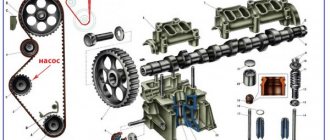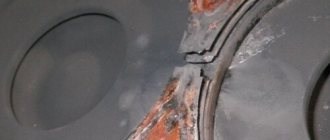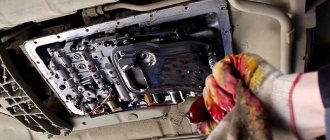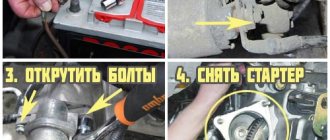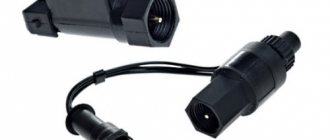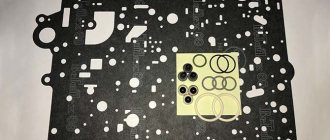The gas distribution mechanism (GRM) synchronizes the operation of the piston group, the fuel injection system and the exhaust of combustion products. If you are wondering how to change the timing belt, we will provide the necessary minimum information that will help present this procedure as a whole. This will make it easier to decide whether replacing the timing belt is worth your own efforts, or whether it is better to entrust this work to specialists.
The timing belt is the most responsible and important belt drive in a car. Its breakage is a big nuisance. You'll be lucky if the problem is limited to bent valves. Therefore, the answer to the question of how to replace the timing belt should be given immediately as soon as you suspect a problem with its operation. In this case, it is better to play it safe than to have serious repairs in the future.
Where is the timing belt located?
First, let's remember where the timing belt is located and what it looks like. Its location is in front of the engine, but do not forget that motors come in longitudinal and transverse locations. In most cases, gas distribution mechanisms use a toothed rubber belt, but in a considerable number of car models from different manufacturers, a steel chain is also used for this.
Engine cylinders can be equipped with two or four valves with one and two camshafts (CV), respectively. The kinematics of the gas distribution mechanisms of such engines differ. We will show them using the example of 8- and 16-valve power units for the VAZ 2110, 2111 and 2112.
The scheme with two shafts is more complicated, and in it, in addition to the pulley of the second RV, a support roller is added. This also complicates the belt replacement procedure. It is most difficult to perform this operation after a break or severe stretching of the belt, when the factory timing settings can be completely lost. Replacing in normal mode is not so difficult that you can’t try to do it yourself.
What is needed to replace the timing belt
The leading link of the gas distribution mechanism is the crankshaft. It sets the pace of operation of the timing belt. Rotation at high speed and friction forces lead to fairly rapid stretching and wear of the belt. However, the decision about what to change when replacing the timing belt is made after a careful inspection of the mechanism.
It is checked for the presence of play in the tension and support rollers, the absence of oil leaks, and the serviceability of the water pump, the drive (pulley) of which is part of the timing belt, is determined. Therefore, when repairing the gas distribution mechanism, you may need more than just a belt. To replace it, you will definitely need the following set of tools:
- a set of open-end, socket and ring wrenches Nos. 10, 13, 17, including a special fork wrench for fixing the tension roller;
- a torque wrench for tightening the nuts with the required force;
- a device for checking belt tension;
- screwdrivers;
- jack.
Before you begin replacing the timing belt, you should prepare the vehicle. First of all, the car needs to be fixed so that it does not rock back and forth. Remove the front right wheel and the protection under it, as well as other parts that may cause you inconvenience when working. After removing the protection, return the wheel to its place. It is most convenient to combine marks and marks on timing pulleys and engine body parts.
Should I buy an official or unofficial belt?
The safest way to purchase a high-quality timing belt is to purchase from an official service center. As an added bonus, installation will often be done there. Unfortunately, this option turns out to be the most expensive.
Here it is important to know that among official services there is a practice of listing the spare part in the catalog under the brand of the car manufacturer, and not the part itself. Take branded timing belts for Chevrolet and Opel cars as an example.
Regardless of the actual manufacturer of the part, it will be offered under the GM brand, although the spare part will actually be produced at Gates factories.
Almost every car owner has encountered a similar situation. How to check the timing belt? It is enough to remove the part yourself at least once and look at the markings on it: according to the catalogs it was made by GM, Audi, etc., but according to the markings, for example, Contitech.
The disadvantage of this approach becomes visible if you compare the price with the same model under your own brand on the market. As a rule, the difference with the service is approximately 1.5 times. However, there is absolutely no difference in quality. That is why it is difficult to say how much a timing belt costs - it all depends on the manufacturer.
However, some drivers hold an alternative opinion: they believe that only the best products from one manufacturer or another are used for original spare parts, and everything else goes on open sale in the form of a kind of “markdown”.
Practice shows that original and non-original timing belts serve approximately equally. Thus, it will be enough to find out the factory model of the part so that you can purchase it immediately and not overpay for service.
The only point: you must buy from a trusted dealer, since otherwise there is a high risk of running into a low-quality fake. As a result, a timing belt break can occur much earlier with a much higher probability.
So, which timing belt is best? Designed specifically for your vehicle and purchased from a reliable supplier.
Replacing the timing belt. Video:
Do-it-yourself timing belt replacement
Here we suggest looking at a photo report on how to change the timing belt on a VAZ with a 16-valve engine. The procedure is performed in the following sequence of actions:
- Remove the alternator belt from the pulley on the crankshaft.
- Remove the timing belt guard cover.
- Align the marks of the RV pulleys according to the marks on the casing.
- Remove the generator drive pulley, check again and set the marks, adding the crankshaft to this, after which you can remove the tension roller, and after it the belt.
- Check the condition of the belt and rollers.
- Reinstall the belt.
- Install the tension roller.
- Tension the belt.
- Finally check the correspondence of the labels.
- Perform a test run of the engine and complete assembly.
When to change
At what mileage does the timing belt need to be replaced? Depending on the car model, the timing belt is changed after 50 - 150 thousand km. But the wear rate is additionally affected by the operating conditions of the vehicle.
If the car is used in a taxi, is operated at low or high temperatures, or the driving style is quite aggressive, then the timing belt will wear out faster. This must be taken into account and at each maintenance request an inspection of the condition of this part.
The frequency of replacing the timing belt is indicated in the service book for the car. To formulate more precisely, the reasons for “early” wear of the timing belt include:
- Frequent operation of the vehicle at high engine speeds;
- Bad roads (the crankshaft spins);
- Ingress of technical fluids (oil, coolant, etc.), resulting in belt “slippage” and increased wear due to this;
- Low quality fake at last replacement;
- Jamming of bearings in tension rollers;
- Worn water pump bearings. The gear jams and the belt breaks.
Read here DIY lamp - 130 photos of original and stylish ideas on how to make a homemade lamp from improvised materials
Important! A broken timing belt can lead to engine repair! Depending on where the valves were when they broke, they may need to be replaced. This is due to the fact that despite the camshaft stopping, the pistons continue to move both up and down.
The pistons themselves can also be damaged as a result of an impact when the timing belt breaks. This will lead to complete disassembly of the engine. Such a breakdown is most likely in 16-valve engines, since in 8-valve engines the designers provide for the possibility of such a breakdown and increase the distances between parts; this can be done there.




